
The Project Gutenberg EBook of Texas Waterfowl Identification Guide, by Central Flyway Council This eBook is for the use of anyone anywhere in the United States and most other parts of the world at no cost and with almost no restrictions whatsoever. You may copy it, give it away or re-use it under the terms of the Project Gutenberg License included with this eBook or online at www.gutenberg.org. If you are not located in the United States, you'll have to check the laws of the country where you are located before using this ebook. Title: Texas Waterfowl Identification Guide Author: Central Flyway Council Release Date: April 5, 2017 [EBook #54487] Language: English Character set encoding: UTF-8 *** START OF THIS PROJECT GUTENBERG EBOOK TEXAS WATERFOWL IDENT. GUIDE *** Produced by Stephen Hutcheson, MFR and the Online Distributed Proofreading Team at http://www.pgdp.net

Published by
The Central Flyway Council
The Central Flyway Council wishes to thank the Atlantic Flyway Council for making available the illustrations and most of the text of this booklet.
The Council also wishes to thank the many persons who assisted in preparation of this publication, particularly the Vermont Fish and Game Commission and Alan R. Munro, the artist.
PRINTED IN U.S.A.
BY THE LANE PRESS. INC. · BURLINGTON, VERMONT
The North American continent, at the time of its discovery and early settlement, had a waterfowl population which was one of its many wonders. So far as the evidence shows, no equal area of the earth’s surface ever supported such vast numbers of so many different ducks and geese, and this situation persisted to a time within the memory of living men. Long after the end of early settlement on this continent, hunting was free and harvest unlimited. But as the advancing tide of settlement reached into the north-central prairie states and provinces in the final years of the Nineteenth Century, radical changes began. From that time on North American waterfowl habitat began to deteriorate. Literally millions of acres of former nesting ground in the north have now been drained and put to the plow. South of the breeding range, not only agriculture, but industrialization and urbanization also have steadily reduced available resting and wintering grounds.
The progressive decline in waterfowl numbers which followed these changes in land use led eventually to the scientific management of waterfowl. Spring shooting and market hunting were abolished in the second decade of this century. Ten years later the federal government undertook detailed regulation of migratory waterfowl so the annual harvest could be made proportional to the annual production. This was accomplished through collective effort by State, Provincial and Federal agencies of Canada, Mexico and the United States to obtain scientific information. In keeping with biological principles, most of the restrictions on bag limit and means of taking have been used with some flexibility.
Throughout the decline of all waterfowl populations some species have been underharvested. These species have declined in about the same proportion as those species on which the bulk of the harvest occurred. The Central Flyway Council feels that a refinement in waterfowl management is possible by directing hunting pressure on these previously underharvested species. This goal can only be accomplished through a knowledge of species identification by the waterfowl hunter. This booklet is a start in that direction.
In recent years most waterfowl populations have made encouraging recoveries from the low point of the early 1930’s, when disastrous drouths, drainage and changing land use patterns took their toll. Still drainage continues, and industrialization is further reducing the habitat. Hunting continues as a major sport, however, 6 maximum utilization of all species must be accomplished if hunting is to be fostered at a reasonable level of freedom and enjoyment.
The very future of duck hunting depends upon a more effective partnership between regulatory agencies and the many thousands of gunners whom they serve. The federal agency is charged by treaty and law with husbandry of the waterfowl resource. The State agencies assist in the responsibility. However, they need the help of all sportsmen, and particularly they need the understanding help of waterfowlers who know their birds and who keep abreast of current plans for management. To foster this essential cooperation between agencies and gunners is a primary purpose of this booklet.
Identification of birds in the field, and particularly on the wing, as ducks and geese are usually seen over decoys, is easier than appears at first try. The trick is to note, in addition to shape and approximate size, the general arrangement of light and dark areas in the plumage, for nearly every species has its own distinctive pattern. With practice, the eye can be trained to pick out this pattern at a glance, and within a short time recognition becomes automatic. The illustrations which follow, one for each important species of Central Flyway waterfowl, make use of this practice of “pattern recognition” in the two or more flying birds at the top of the page. Actually in many cases recognition by flight pattern and flight characteristics will soon become evident.
In each drawing of ducks the flying female leads, with the drake following, for this is the usual order in a mated pair during winter, and spring. On the lower part of each page are shown enlarged heads, adult male on the left, female on the right, with an immature head added when the difference is substantial, or with certain details which further aid identification when the bird is in hand. All ducks, both flying pairs and heads, are drawn in direct proportion to each other, but geese, because of their larger size, are reduced one third from the duck proportion.
Drawings of geese show only a single enlarged head on each plate because male and female geese are alike in color pattern. Finally, some birds which are not “waterfowl” in the strict sense of the word, but are nevertheless often seen, are shown in the last few illustrations. Some of them (loon, grebe, and cormorant), although protected at all times, are included because they are 7 often mistakenly shot for waterfowl. Others (rails, coot, and snipes) are included because they occupy wet-land habitat along with ducks.
Although “pattern recognition” simplifies the problem of identification for the waterfowler, there are still several complications to be considered. Of these, the most troublesome by far is the matter of moults. The adult drakes of most species of ducks, very soon after the hens begin to incubate eggs, moult the bright body-feathers of their breeding dress and assume an “eclipse” plumage which resembles the year-round coloration of the female. This dull plumage, serving as a protective factor during the wing-moult which follows, is retained until the new flight feathers are fully developed. By September a second body-moult is under way by which these old drakes assume the bright courting plumage of late fall and winter. During the same period, the young males of the year, whose juvenile plumage likewise resembles the female dress, are also assuming the adult plumage. Following December 1 most difficulties of identification by reason of the moult are resolved, but in early fall the hunter may be puzzled by some of the transition plumages noted on birds in his bag. Identification during this period may appear extremely difficult, but it is well to remember that wing patterns remain virtually unchanged regardless of stage of the moult.
The remaining problems of identification require only brief mention for they appear but rarely. In the first place, this booklet includes all species of ducks and geese which occur in numbers in any part of the Central Flyway, but omits others which may be occasional visitors. Second, hybrids are rather frequent among waterfowl, and some are extremely puzzling. In such special cases as these your local wildlife manager or biologist may be able to help.
The following publications contain further information for the hunter interested in additional facts of natural history, distribution and description:
For the nonhunter—and many avid outdoorsmen prefer to watch rather than shoot—this guide to waterfowl can provide enjoyment beyond the simple pleasure of seeing ducks and geese. Most of us remember seeing some “oldtimer” identify flights or singles or rafts of birds at what seemed impossible distances. The ability to do this does not really stem from some mystic communion with the birds. Rather, through such a booklet as this the waterfowling layman can develop the same powers in himself. For the cost of a little concentrated effort he can gain great personal satisfaction and the increased understanding that comes from resolving “ducks” into the wide variety of individual species they really are.
Further, some knowledge of waterfowl distribution, annual abundance and the approximate source and destination of the ducks and geese he hunts, will often help the waterfowler understand the overall picture of waterfowl management. For both administrative and biological purposes of waterfowl management, the United States is divided into four flyways—the Atlantic, the Mississippi, the Pacific, and the one for which this booklet is written, the Central. Each flyway has its own segment of the waterfowl population, subject to different conditions and pressures than the populations of other flyways, and therefore is administered as a separate unit. In general this is a sound premise, but it must not be considered too rigid. Since the flyway principle is in part an administrative device, it is important principally in fall and winter when most North American waterfowl are within the United States. As the wintering populations begin to move northward in the spring, many species disperse throughout the nesting grounds of the northern states and Canada. Much overlapping of the populations from various flyways in which the birds wintered occurs.
Methods developed over the years and applied systematically supply information which is necessary to intelligent management. Breeding pair and brood surveys indicate the distribution of nesting populations, and their success from year to year in hatching and raising their broods of young. The banding of waterfowl, carefully aged, sexed, and released, gives specific information on the 9 travels of individual birds, on mortality, and on some phases of hunting pressure. Periodic air-counts in late summer and fall serve to measure, in a rough way, the distribution of different species during southward migration, and the rate of movement. Hunter-bag checks, carried out in the field during the shooting season, complement fall counts with regard to distribution at given points. A post-season sampling of hunter success, by mail, supplies data on additional aspects of hunting pressure, and gives an index of total kill. Finally, the annual winter count indicates the distribution and relative size of populations remaining after the shooting season ends. In combination, these methods are steadily increasing our knowledge of North American waterfowl, and in particular are providing the sort of “running inventory” which is the first requirement for intelligent management of this resource.
The Central Flyway Council is the clearing house for coordinated planning in this Flyway. It is a delegate organization, including in its membership administrative and technical representatives from the fish and game departments of all states and provinces in the flyway. A Flyway Representative has been assigned from the Fish and Wildlife Service. This group is concerned with all phases of waterfowl research and management in the flyway. The Central Flyway Council provides for an effective interchange of information between member agencies and assists in the coordination and integration of flyway management programs. These purposes have been furthered by regular meetings for the open discussion of flyway problems.
In early 1953, the Council and the Fish and Wildlife Service, acting jointly, adopted a flyway program which has been expanded and improved as factual information and experience dictate. This program outlines objectives and suggests methods and priorities for accomplishment. State game departments now pattern their activities around the flyway program.
Extending the cooperative idea, the Council has joined with corresponding organizations from the other flyways to form the National Waterfowl Council, which annually participates in the official discussion of continental and flyway management problems and regulations. From their inception, the flyway councils 10 have been successful in promoting understanding and teamwork so necessary for the perpetuation of the waterfowl resource.
As an individual reader of this booklet, you have a part to play in the essential partnership between agencies and waterfowlers. Your part may be small and may take various forms, depending on the circumstances, but certainly it is there. Perhaps, having sent in one or two waterfowl bands in the past and having experienced the initial novelty of hearing where your birds came from, you now forget to report them. The next time you have this choice between reporting or forgetting a band, remember that its prompt recovery, with full data, might be the clue to some missing fact to improve your future gunning.
Hunter bag checks indicate crippling losses in the Central Flyway run to an average of about one quarter of the total kill. In certain marshes, early in the season, crippling can greatly exceed the one quarter loss. Shooting at birds on the fringe of effective killing range is a crippling practice and, moreover, as you probably know from observation is contagious. The usual effect of one “sky shooter” in a marsh is to force other gunners nearby to attempt impossible shots which increase crippling losses and soon ruin shooting for everybody. Controlling such practices lies solely in the hands of individual gunners. With large-gauge guns of modified bore, the shot-pattern that will produce kills should be consistent up to forty yards, a distance well within capabilities of the average gunner to hold and compute necessary lead. Successful duck shooting is a matter of good judgment. To avoid errors in judgment drive stakes in front of your blind at distances of thirty and forty yards to indicate safe killing range. Hold your fire until the feet of an incoming duck can be seen distinctly, for only then will the bird be in range. Good sportsmanship in duck blinds and marshes is equally as important as remaining friendly with your home neighbors. Train a good retrieving dog, and add to your day’s pleasure by watching him at work on downed birds.
Above all, remember that the future of waterfowling is partly in your hands—that your good sportsmanship and cooperation are as necessary to the work of the Central Flyway Council and its member agencies as their activities are to you.
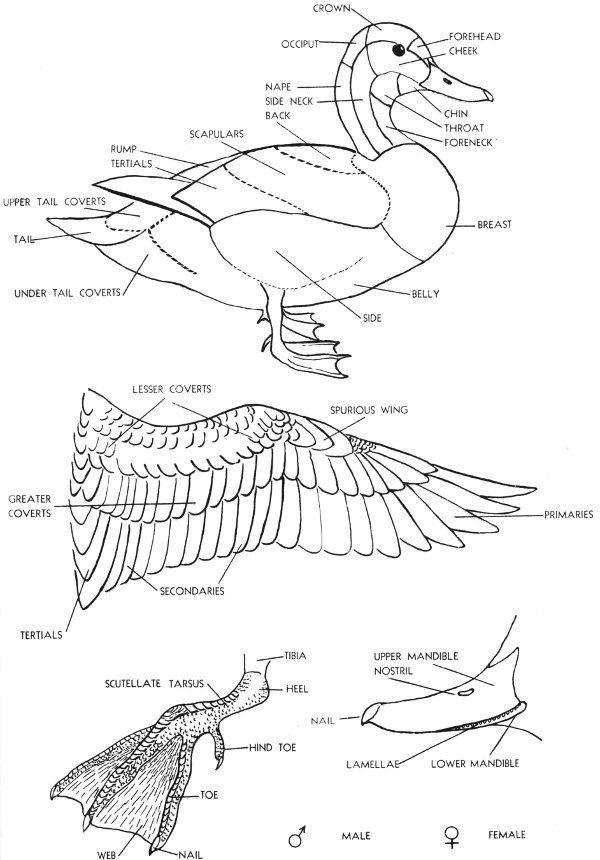















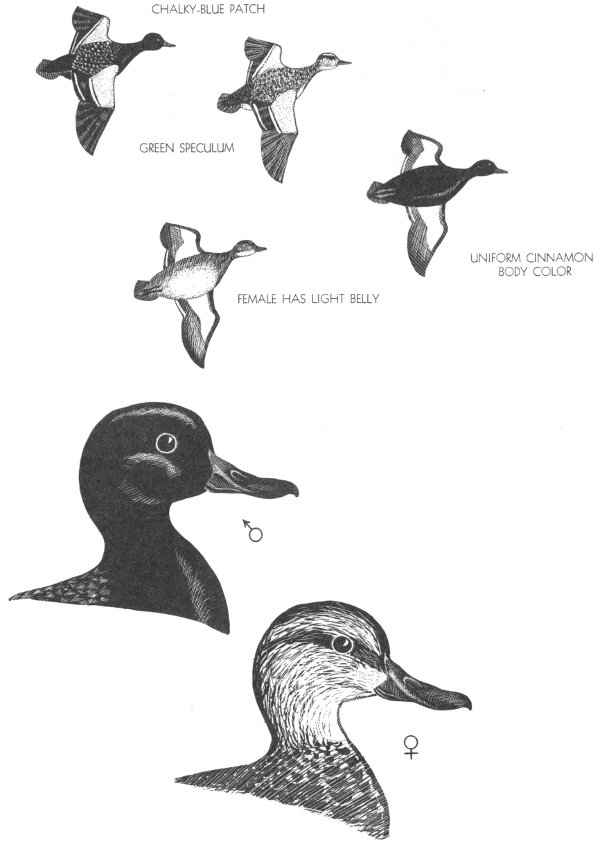

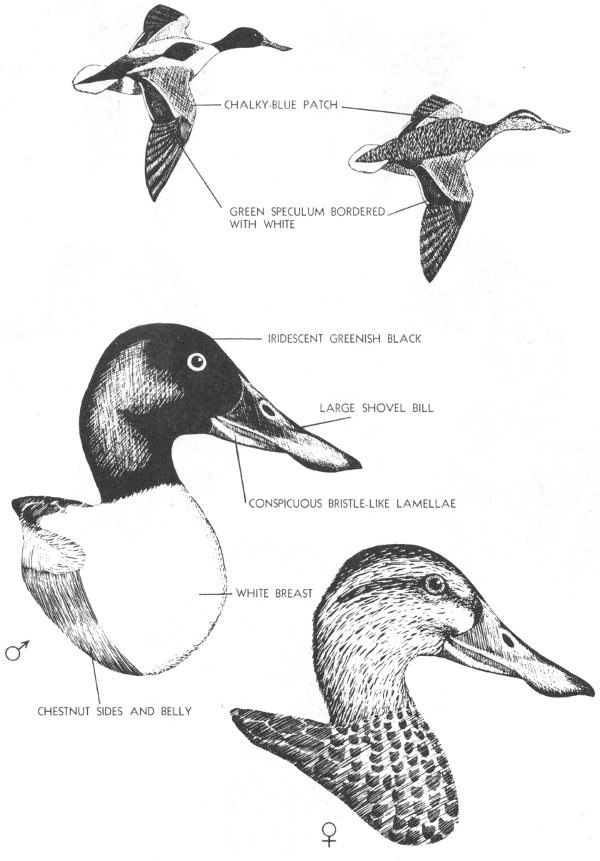







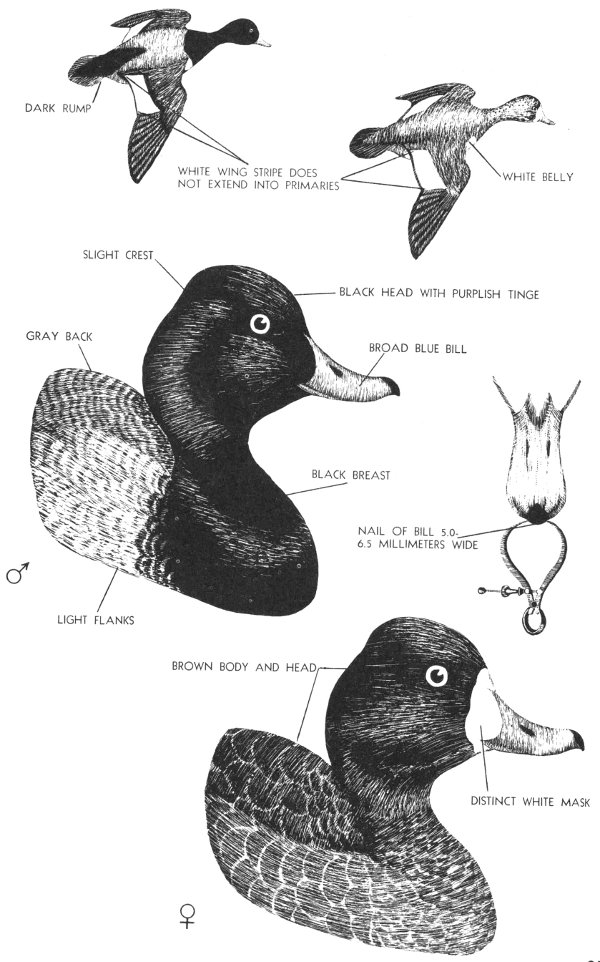

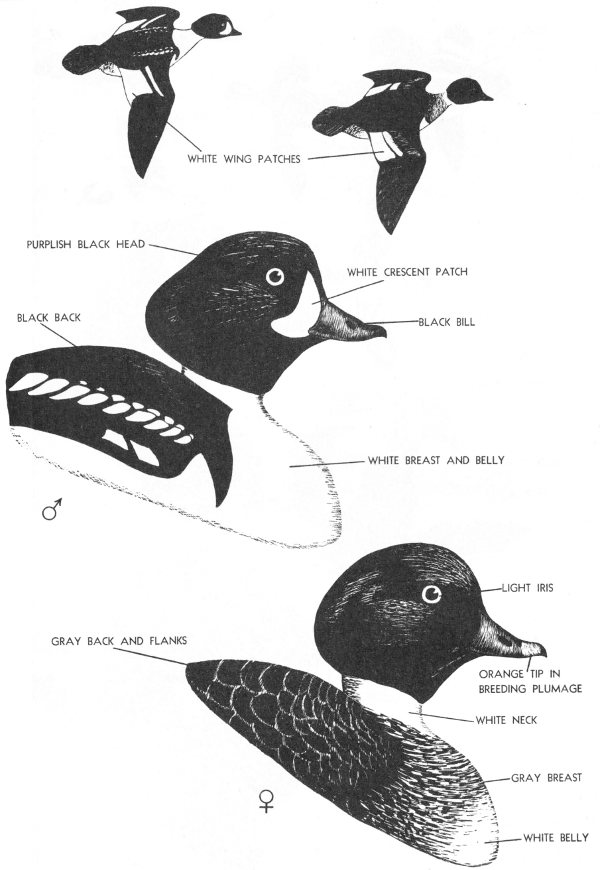










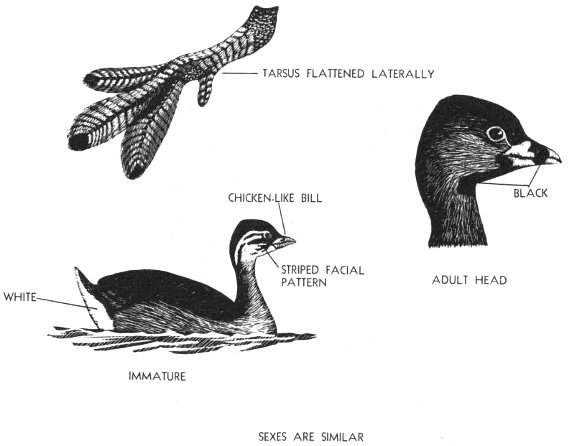




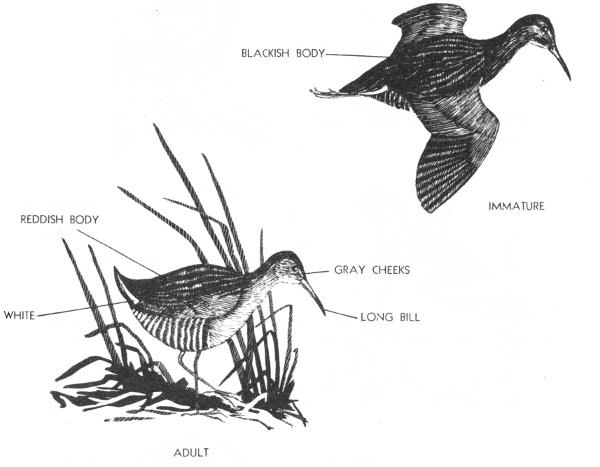
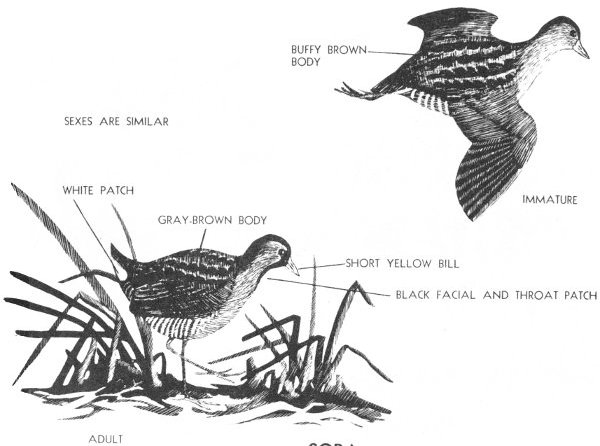

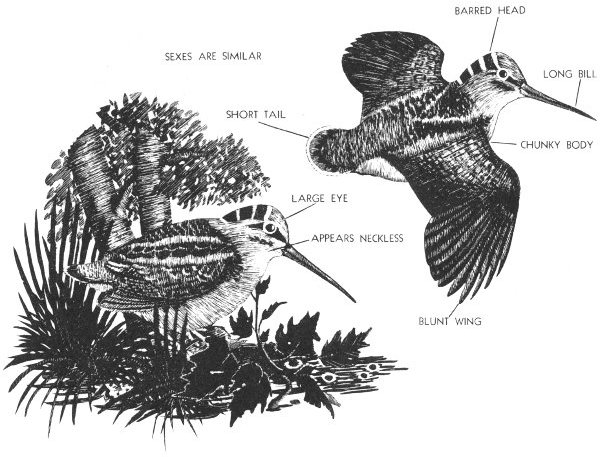
Buy a State License, and if You Are 16 Years of Age or Older Obtain Federal Duck Stamp. It is illegal to hunt waterfowl without these licenses, and the dollars you spend for them help to maintain your sport.
Know Your State, Provincial and Federal Migratory Bird Laws. When in doubt consult your local game protector or U.S. Game Management Agent.
Treat the Landowner with Respect and Courtesy. Ownership of game is vested in the State and Province, but landowners have the right to prevent trespass on their land.
Learn to Identify Before You Shoot. A mistake may prove both embarrassing and costly, a correct identification adds to your day’s enjoyment.
Cooperate with Your Federal, State and Provincial Agencies. Solving the many problems of waterfowl production, harvest and research is possible only through continued cooperation of the duck hunter and conservationist.
Use a Retriever if Possible, or at Least Pick Up Every Bird You Shoot. A good dog will pick up cripples you would otherwise have to leave. A good sportsman will never kill game needlessly. The use of retrieving dogs is a sound conservation practice in reducing crippling losses in addition to providing the pleasure of watching a good dog in action.
Good Sportsmanship in the Duck Blind and on the Marshes Is Equally Important as Remaining Friendly with Your Neighbors.
DISTRIBUTED BY:
TEXAS GAME and FISH COMMISSION
End of the Project Gutenberg EBook of Texas Waterfowl Identification Guide, by
Central Flyway Council
*** END OF THIS PROJECT GUTENBERG EBOOK TEXAS WATERFOWL IDENT. GUIDE ***
***** This file should be named 54487-h.htm or 54487-h.zip *****
This and all associated files of various formats will be found in:
http://www.gutenberg.org/5/4/4/8/54487/
Produced by Stephen Hutcheson, MFR and the Online
Distributed Proofreading Team at http://www.pgdp.net
Updated editions will replace the previous one--the old editions will
be renamed.
Creating the works from print editions not protected by U.S. copyright
law means that no one owns a United States copyright in these works,
so the Foundation (and you!) can copy and distribute it in the United
States without permission and without paying copyright
royalties. Special rules, set forth in the General Terms of Use part
of this license, apply to copying and distributing Project
Gutenberg-tm electronic works to protect the PROJECT GUTENBERG-tm
concept and trademark. Project Gutenberg is a registered trademark,
and may not be used if you charge for the eBooks, unless you receive
specific permission. If you do not charge anything for copies of this
eBook, complying with the rules is very easy. You may use this eBook
for nearly any purpose such as creation of derivative works, reports,
performances and research. They may be modified and printed and given
away--you may do practically ANYTHING in the United States with eBooks
not protected by U.S. copyright law. Redistribution is subject to the
trademark license, especially commercial redistribution.
START: FULL LICENSE
THE FULL PROJECT GUTENBERG LICENSE
PLEASE READ THIS BEFORE YOU DISTRIBUTE OR USE THIS WORK
To protect the Project Gutenberg-tm mission of promoting the free
distribution of electronic works, by using or distributing this work
(or any other work associated in any way with the phrase "Project
Gutenberg"), you agree to comply with all the terms of the Full
Project Gutenberg-tm License available with this file or online at
www.gutenberg.org/license.
Section 1. General Terms of Use and Redistributing Project
Gutenberg-tm electronic works
1.A. By reading or using any part of this Project Gutenberg-tm
electronic work, you indicate that you have read, understand, agree to
and accept all the terms of this license and intellectual property
(trademark/copyright) agreement. If you do not agree to abide by all
the terms of this agreement, you must cease using and return or
destroy all copies of Project Gutenberg-tm electronic works in your
possession. If you paid a fee for obtaining a copy of or access to a
Project Gutenberg-tm electronic work and you do not agree to be bound
by the terms of this agreement, you may obtain a refund from the
person or entity to whom you paid the fee as set forth in paragraph
1.E.8.
1.B. "Project Gutenberg" is a registered trademark. It may only be
used on or associated in any way with an electronic work by people who
agree to be bound by the terms of this agreement. There are a few
things that you can do with most Project Gutenberg-tm electronic works
even without complying with the full terms of this agreement. See
paragraph 1.C below. There are a lot of things you can do with Project
Gutenberg-tm electronic works if you follow the terms of this
agreement and help preserve free future access to Project Gutenberg-tm
electronic works. See paragraph 1.E below.
1.C. The Project Gutenberg Literary Archive Foundation ("the
Foundation" or PGLAF), owns a compilation copyright in the collection
of Project Gutenberg-tm electronic works. Nearly all the individual
works in the collection are in the public domain in the United
States. If an individual work is unprotected by copyright law in the
United States and you are located in the United States, we do not
claim a right to prevent you from copying, distributing, performing,
displaying or creating derivative works based on the work as long as
all references to Project Gutenberg are removed. Of course, we hope
that you will support the Project Gutenberg-tm mission of promoting
free access to electronic works by freely sharing Project Gutenberg-tm
works in compliance with the terms of this agreement for keeping the
Project Gutenberg-tm name associated with the work. You can easily
comply with the terms of this agreement by keeping this work in the
same format with its attached full Project Gutenberg-tm License when
you share it without charge with others.
1.D. The copyright laws of the place where you are located also govern
what you can do with this work. Copyright laws in most countries are
in a constant state of change. If you are outside the United States,
check the laws of your country in addition to the terms of this
agreement before downloading, copying, displaying, performing,
distributing or creating derivative works based on this work or any
other Project Gutenberg-tm work. The Foundation makes no
representations concerning the copyright status of any work in any
country outside the United States.
1.E. Unless you have removed all references to Project Gutenberg:
1.E.1. The following sentence, with active links to, or other
immediate access to, the full Project Gutenberg-tm License must appear
prominently whenever any copy of a Project Gutenberg-tm work (any work
on which the phrase "Project Gutenberg" appears, or with which the
phrase "Project Gutenberg" is associated) is accessed, displayed,
performed, viewed, copied or distributed:
This eBook is for the use of anyone anywhere in the United States and
most other parts of the world at no cost and with almost no
restrictions whatsoever. You may copy it, give it away or re-use it
under the terms of the Project Gutenberg License included with this
eBook or online at www.gutenberg.org. If you are not located in the
United States, you'll have to check the laws of the country where you
are located before using this ebook.
1.E.2. If an individual Project Gutenberg-tm electronic work is
derived from texts not protected by U.S. copyright law (does not
contain a notice indicating that it is posted with permission of the
copyright holder), the work can be copied and distributed to anyone in
the United States without paying any fees or charges. If you are
redistributing or providing access to a work with the phrase "Project
Gutenberg" associated with or appearing on the work, you must comply
either with the requirements of paragraphs 1.E.1 through 1.E.7 or
obtain permission for the use of the work and the Project Gutenberg-tm
trademark as set forth in paragraphs 1.E.8 or 1.E.9.
1.E.3. If an individual Project Gutenberg-tm electronic work is posted
with the permission of the copyright holder, your use and distribution
must comply with both paragraphs 1.E.1 through 1.E.7 and any
additional terms imposed by the copyright holder. Additional terms
will be linked to the Project Gutenberg-tm License for all works
posted with the permission of the copyright holder found at the
beginning of this work.
1.E.4. Do not unlink or detach or remove the full Project Gutenberg-tm
License terms from this work, or any files containing a part of this
work or any other work associated with Project Gutenberg-tm.
1.E.5. Do not copy, display, perform, distribute or redistribute this
electronic work, or any part of this electronic work, without
prominently displaying the sentence set forth in paragraph 1.E.1 with
active links or immediate access to the full terms of the Project
Gutenberg-tm License.
1.E.6. You may convert to and distribute this work in any binary,
compressed, marked up, nonproprietary or proprietary form, including
any word processing or hypertext form. However, if you provide access
to or distribute copies of a Project Gutenberg-tm work in a format
other than "Plain Vanilla ASCII" or other format used in the official
version posted on the official Project Gutenberg-tm web site
(www.gutenberg.org), you must, at no additional cost, fee or expense
to the user, provide a copy, a means of exporting a copy, or a means
of obtaining a copy upon request, of the work in its original "Plain
Vanilla ASCII" or other form. Any alternate format must include the
full Project Gutenberg-tm License as specified in paragraph 1.E.1.
1.E.7. Do not charge a fee for access to, viewing, displaying,
performing, copying or distributing any Project Gutenberg-tm works
unless you comply with paragraph 1.E.8 or 1.E.9.
1.E.8. You may charge a reasonable fee for copies of or providing
access to or distributing Project Gutenberg-tm electronic works
provided that
* You pay a royalty fee of 20% of the gross profits you derive from
the use of Project Gutenberg-tm works calculated using the method
you already use to calculate your applicable taxes. The fee is owed
to the owner of the Project Gutenberg-tm trademark, but he has
agreed to donate royalties under this paragraph to the Project
Gutenberg Literary Archive Foundation. Royalty payments must be paid
within 60 days following each date on which you prepare (or are
legally required to prepare) your periodic tax returns. Royalty
payments should be clearly marked as such and sent to the Project
Gutenberg Literary Archive Foundation at the address specified in
Section 4, "Information about donations to the Project Gutenberg
Literary Archive Foundation."
* You provide a full refund of any money paid by a user who notifies
you in writing (or by e-mail) within 30 days of receipt that s/he
does not agree to the terms of the full Project Gutenberg-tm
License. You must require such a user to return or destroy all
copies of the works possessed in a physical medium and discontinue
all use of and all access to other copies of Project Gutenberg-tm
works.
* You provide, in accordance with paragraph 1.F.3, a full refund of
any money paid for a work or a replacement copy, if a defect in the
electronic work is discovered and reported to you within 90 days of
receipt of the work.
* You comply with all other terms of this agreement for free
distribution of Project Gutenberg-tm works.
1.E.9. If you wish to charge a fee or distribute a Project
Gutenberg-tm electronic work or group of works on different terms than
are set forth in this agreement, you must obtain permission in writing
from both the Project Gutenberg Literary Archive Foundation and The
Project Gutenberg Trademark LLC, the owner of the Project Gutenberg-tm
trademark. Contact the Foundation as set forth in Section 3 below.
1.F.
1.F.1. Project Gutenberg volunteers and employees expend considerable
effort to identify, do copyright research on, transcribe and proofread
works not protected by U.S. copyright law in creating the Project
Gutenberg-tm collection. Despite these efforts, Project Gutenberg-tm
electronic works, and the medium on which they may be stored, may
contain "Defects," such as, but not limited to, incomplete, inaccurate
or corrupt data, transcription errors, a copyright or other
intellectual property infringement, a defective or damaged disk or
other medium, a computer virus, or computer codes that damage or
cannot be read by your equipment.
1.F.2. LIMITED WARRANTY, DISCLAIMER OF DAMAGES - Except for the "Right
of Replacement or Refund" described in paragraph 1.F.3, the Project
Gutenberg Literary Archive Foundation, the owner of the Project
Gutenberg-tm trademark, and any other party distributing a Project
Gutenberg-tm electronic work under this agreement, disclaim all
liability to you for damages, costs and expenses, including legal
fees. YOU AGREE THAT YOU HAVE NO REMEDIES FOR NEGLIGENCE, STRICT
LIABILITY, BREACH OF WARRANTY OR BREACH OF CONTRACT EXCEPT THOSE
PROVIDED IN PARAGRAPH 1.F.3. YOU AGREE THAT THE FOUNDATION, THE
TRADEMARK OWNER, AND ANY DISTRIBUTOR UNDER THIS AGREEMENT WILL NOT BE
LIABLE TO YOU FOR ACTUAL, DIRECT, INDIRECT, CONSEQUENTIAL, PUNITIVE OR
INCIDENTAL DAMAGES EVEN IF YOU GIVE NOTICE OF THE POSSIBILITY OF SUCH
DAMAGE.
1.F.3. LIMITED RIGHT OF REPLACEMENT OR REFUND - If you discover a
defect in this electronic work within 90 days of receiving it, you can
receive a refund of the money (if any) you paid for it by sending a
written explanation to the person you received the work from. If you
received the work on a physical medium, you must return the medium
with your written explanation. The person or entity that provided you
with the defective work may elect to provide a replacement copy in
lieu of a refund. If you received the work electronically, the person
or entity providing it to you may choose to give you a second
opportunity to receive the work electronically in lieu of a refund. If
the second copy is also defective, you may demand a refund in writing
without further opportunities to fix the problem.
1.F.4. Except for the limited right of replacement or refund set forth
in paragraph 1.F.3, this work is provided to you 'AS-IS', WITH NO
OTHER WARRANTIES OF ANY KIND, EXPRESS OR IMPLIED, INCLUDING BUT NOT
LIMITED TO WARRANTIES OF MERCHANTABILITY OR FITNESS FOR ANY PURPOSE.
1.F.5. Some states do not allow disclaimers of certain implied
warranties or the exclusion or limitation of certain types of
damages. If any disclaimer or limitation set forth in this agreement
violates the law of the state applicable to this agreement, the
agreement shall be interpreted to make the maximum disclaimer or
limitation permitted by the applicable state law. The invalidity or
unenforceability of any provision of this agreement shall not void the
remaining provisions.
1.F.6. INDEMNITY - You agree to indemnify and hold the Foundation, the
trademark owner, any agent or employee of the Foundation, anyone
providing copies of Project Gutenberg-tm electronic works in
accordance with this agreement, and any volunteers associated with the
production, promotion and distribution of Project Gutenberg-tm
electronic works, harmless from all liability, costs and expenses,
including legal fees, that arise directly or indirectly from any of
the following which you do or cause to occur: (a) distribution of this
or any Project Gutenberg-tm work, (b) alteration, modification, or
additions or deletions to any Project Gutenberg-tm work, and (c) any
Defect you cause.
Section 2. Information about the Mission of Project Gutenberg-tm
Project Gutenberg-tm is synonymous with the free distribution of
electronic works in formats readable by the widest variety of
computers including obsolete, old, middle-aged and new computers. It
exists because of the efforts of hundreds of volunteers and donations
from people in all walks of life.
Volunteers and financial support to provide volunteers with the
assistance they need are critical to reaching Project Gutenberg-tm's
goals and ensuring that the Project Gutenberg-tm collection will
remain freely available for generations to come. In 2001, the Project
Gutenberg Literary Archive Foundation was created to provide a secure
and permanent future for Project Gutenberg-tm and future
generations. To learn more about the Project Gutenberg Literary
Archive Foundation and how your efforts and donations can help, see
Sections 3 and 4 and the Foundation information page at
www.gutenberg.org
Section 3. Information about the Project Gutenberg Literary Archive Foundation
The Project Gutenberg Literary Archive Foundation is a non profit
501(c)(3) educational corporation organized under the laws of the
state of Mississippi and granted tax exempt status by the Internal
Revenue Service. The Foundation's EIN or federal tax identification
number is 64-6221541. Contributions to the Project Gutenberg Literary
Archive Foundation are tax deductible to the full extent permitted by
U.S. federal laws and your state's laws.
The Foundation's principal office is in Fairbanks, Alaska, with the
mailing address: PO Box 750175, Fairbanks, AK 99775, but its
volunteers and employees are scattered throughout numerous
locations. Its business office is located at 809 North 1500 West, Salt
Lake City, UT 84116, (801) 596-1887. Email contact links and up to
date contact information can be found at the Foundation's web site and
official page at www.gutenberg.org/contact
For additional contact information:
Dr. Gregory B. Newby
Chief Executive and Director
gbnewby@pglaf.org
Section 4. Information about Donations to the Project Gutenberg
Literary Archive Foundation
Project Gutenberg-tm depends upon and cannot survive without wide
spread public support and donations to carry out its mission of
increasing the number of public domain and licensed works that can be
freely distributed in machine readable form accessible by the widest
array of equipment including outdated equipment. Many small donations
($1 to $5,000) are particularly important to maintaining tax exempt
status with the IRS.
The Foundation is committed to complying with the laws regulating
charities and charitable donations in all 50 states of the United
States. Compliance requirements are not uniform and it takes a
considerable effort, much paperwork and many fees to meet and keep up
with these requirements. We do not solicit donations in locations
where we have not received written confirmation of compliance. To SEND
DONATIONS or determine the status of compliance for any particular
state visit www.gutenberg.org/donate
While we cannot and do not solicit contributions from states where we
have not met the solicitation requirements, we know of no prohibition
against accepting unsolicited donations from donors in such states who
approach us with offers to donate.
International donations are gratefully accepted, but we cannot make
any statements concerning tax treatment of donations received from
outside the United States. U.S. laws alone swamp our small staff.
Please check the Project Gutenberg Web pages for current donation
methods and addresses. Donations are accepted in a number of other
ways including checks, online payments and credit card donations. To
donate, please visit: www.gutenberg.org/donate
Section 5. General Information About Project Gutenberg-tm electronic works.
Professor Michael S. Hart was the originator of the Project
Gutenberg-tm concept of a library of electronic works that could be
freely shared with anyone. For forty years, he produced and
distributed Project Gutenberg-tm eBooks with only a loose network of
volunteer support.
Project Gutenberg-tm eBooks are often created from several printed
editions, all of which are confirmed as not protected by copyright in
the U.S. unless a copyright notice is included. Thus, we do not
necessarily keep eBooks in compliance with any particular paper
edition.
Most people start at our Web site which has the main PG search
facility: www.gutenberg.org
This Web site includes information about Project Gutenberg-tm,
including how to make donations to the Project Gutenberg Literary
Archive Foundation, how to help produce our new eBooks, and how to
subscribe to our email newsletter to hear about new eBooks.